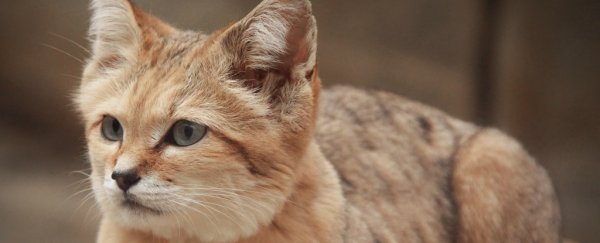For the first time, researchers in the United Arab Emirates have managed to snap photos of three different Arabian sand cats (Felis margarita harrisoni) in the wild - a subspecies of sand cat that's so elusive, scientists barely know anything about it.
These photos – besides being completely awesome to look at – will hopefully shed light on how well the species is fairing, and what can be done to ensure their survival.
"There's an absence of scientists working on sand cats and very few assessments are being made to assess the behaviour, population, and status of the species," John Newby from the Sahara Conservation Fund, who was not involved in the study, told Natasha Khaleeq from New Scientist.
Sand cats are found in the deserts of North Africa and Southwest and Central Asia, and due to their fragmented and declining populations, have been classified as near threatened for more than a decade.
Arabian sand cats are particularly elusive - as a subspecies, they're considered endangered, and they've only been documented anecdotally in the wild, Khaleeq reports, with the last reported sighting in Abu Dhabi having taken place a whopping 10 years ago.
Because of this, researcher Shakeel Ahmed from the Environmental Agency - Abu Dhabi (EAD) decided to lead a team of scientists out into the wild to finally capture the mysterious creatures on film.
In 2015, Admed and his team set out to the Baynouna region of Abu Dhabi armed with camera traps, which they baited with cat food for months – 278 nights to be exact – before finally witnessing an Arabian sand cat in the flesh.
When all was said and done, the team managed to collect a remarkable 46 photos of the species, which they think includes three separate sand cats living in the same area.
From the photos, they were able to suggest that the cats prefer cooler temperatures of about 11 degrees Celsius (52 degrees Fahrenheit) to 28 degrees Celsius (82 degrees Fahrenheit), coming out only in the cover of darkness.
"A total of three individuals were recorded of which one was confirmed as a male. About 80 percent of the sightings were between 00:00 and 06:00 hours, and 39 percent were recorded during the full moon phase," the team states in their report. "These are the first confirmed sightings of the presence of Arabian sand cat in the western region of Abu Dhabi Emirate after an unconfirmed sighting reported in 2005."
Besides the sand cats, the team was also able to capture a few other small animals on film, such as the Cheeseman's gerbil and the lesser jerboa, and a few reptiles, including geckos and Arabian sand skinks, which could give an indication of the type of prey the cats are living off.
 One of the photos by the Environment Agency - Abu Dhabi
One of the photos by the Environment Agency - Abu Dhabi
Hopefully, the new sightings will help biologists to further understand Arabian sand cats, and enable us to protect them from extinction.
"It is clear that field research will all be extremely valuable in putting together conservations plans for the sand cats and their habitat, as well as pin-pointing those areas and their extent that may be turned into protected areas to conserve the cats," Newby explains to New Scientist. "Scientists need to be doing more research on how the sand cats live in order to create a suitable protected area."
The team's findings were published in the European Journal of Wildlife Research.
